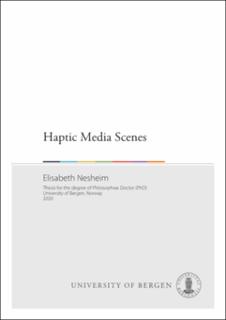| dc.description.abstract | The aim of this thesis is to apply new media phenomenological and enactive embodied cognition approaches to explain the role of haptic sensitivity and communication in personal computer environments for productivity. Prior theory has given little attention to the role of haptic senses in influencing cognitive processes, and do not frame the richness of haptic communication in interaction design—as haptic interactivity in HCI has historically tended to be designed and analyzed from a perspective on communication as transmissions, sending and receiving haptic signals. The haptic sense may not only mediate contact confirmation and affirmation, but also rich semiotic and affective messages—yet this is a strong contrast between this inherent ability of haptic perception, and current day support for such haptic communication interfaces. I therefore ask: How do the haptic senses (touch and proprioception) impact our cognitive faculty when mediated through digital and sensor technologies? How may these insights be employed in interface design to facilitate rich haptic communication? To answer these questions, I use theoretical close readings that embrace two research fields, new media phenomenology and enactive embodied cognition. The theoretical discussion is supported by neuroscientific evidence, and tested empirically through case studies centered on digital art. I use these insights to develop the concept of the haptic figura, an analytical tool to frame the communicative qualities of haptic media. The concept gauges rich machine- mediated haptic interactivity and communication in systems with a material solution supporting active haptic perception, and the mediation of semiotic and affective messages that are understood and felt. As such the concept may function as a design tool for developers, but also for media critics evaluating haptic media. The tool is used to frame a discussion on opportunities and shortcomings of haptic interfaces for productivity, differentiating between media systems for the hand and the full body. The significance of this investigation is demonstrating that haptic communication is an underutilized element in personal computer environments for productivity and providing an analytical framework for a more nuanced understanding of haptic communication as enabling the mediation of a range of semiotic and affective messages, beyond notification and confirmation interactivity. | en_US |

